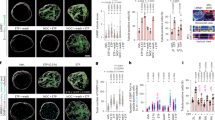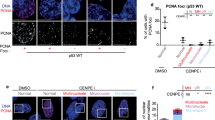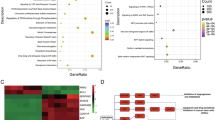Abstract
53BP1 is a mediator of DNA damage response (DDR) and a tumor suppressor whose accumulation on damaged chromatin promotes DNA repair and enhances DDR signaling. Using foci formation of 53BP1 as a readout in two human cell lines, we performed an siRNA-based functional high-content microscopy screen for modulators of cellular response to ionizing radiation (IR). Here, we provide the complete results of this screen as an information resource, and validate and functionally characterize one of the identified ‘hits’: a nuclear pore component NUP153 as a novel factor specifically required for 53BP1 nuclear import. Using a range of cell and molecular biology approaches including live-cell imaging, we show that knockdown of NUP153 prevents 53BP1, but not several other DDR factors, from entering the nuclei in the newly forming daughter cells. This translates into decreased IR-induced 53BP1 focus formation, delayed DNA repair and impaired cell survival after IR. In addition, NUP153 depletion exacerbates DNA damage caused by replication stress. Finally, we show that the C-terminal part of NUP153 is required for effective 53BP1 nuclear import, and that 53BP1 is imported to the nucleus through the NUP153–importin-β interplay. Our data define the structure–function relationships within this emerging 53BP1-NUP153/importin-β pathway and implicate this mechanism in the maintenance of genome integrity.
Similar content being viewed by others
Log in or create a free account to read this content
Gain free access to this article, as well as selected content from this journal and more on nature.com
or
Abbreviations
- 53BP1:
-
p53-Binding Protein 1
- ANAPC10:
-
anaphase-promoting complex subunit 10
- ANAPC4:
-
anaphase-promoting complex subunit 4
- APC/C:
-
anaphase-promoting complex/cyclosome
- APH:
-
aphidicolin
- ASB18:
-
ankyrin repeat and SOCS box protein 18
- ATM:
-
ataxia telangiectasia mutated
- ATR:
-
ataxia telangiectasia and Rad3-related protein
- ATXN7:
-
ataxin-7
- BRCA1:
-
breast cancer type 1 susceptibility protein
- DDR:
-
DNA damage response
- DNA-PK:
-
DNA-dependent protein kinase
- DSB:
-
Double strand breaks
- ECS, elongin, Cullin:
-
SOCS-box containing complex
- FANCD2:
-
Fanconi anemia group D2 protein
- FG repeat:
-
phenylalanine-glycine repeat
- GFP:
-
green fluorescent protein
- γH2AX:
-
phosphorylated histone H2AX at serine 139
- HeLa:
-
human adenocarcinoma cell line
- HERC2:
-
HECT domain and RCC1-like domain-containing protein 2
- IR:
-
ionizing radiation
- MAP3K3:
-
mitogen-activated protein kinase kinase kinase 3
- MDC1:
-
mediator of DNA damage checkpoint protein 1
- Mec1:
-
Mitosis entry checkpoint protein 1
- MMSET:
-
multiple myeloma SET domain-containing protein
- NBS1:
-
Nijmegen breakage syndrome protein 1
- NPC:
-
nuclear pore complex
- NUP:
-
nucleoporin
- NUP153:
-
nucleoporin 153kDa protein
- NUP84:
-
nucleoporin 84kDa protein
- NUP93:
-
nucleoporin 93kDa protein
- PARP:
-
poly [ADP-ribose] polymerase
- PIAS4:
-
protein inhibitor of activated STAT protein 4
- Rad51:
-
DNA repair protein RAD51
- Rad53:
-
Serine/threonine-protein kinase RAD53
- RNF8:
-
RING finger protein 8
- RNF168:
-
RING finger protein 168
- SAGA:
-
Spt-Ada-Gcn5 acetyltransferase
- SCF, Skp, Cullin:
-
F-box containing complex
- SEC13L1:
-
SEC13-like protein 1
- SET8:
-
SET domain-containing protein 8
- Slx5:
-
synthetic lethal of unknown function protein 5
- Slx8:
-
synthetic lethal of unknown function protein 8
- TopBP1:
-
DNA topoisomerase 2-binding protein 1
- U2OS:
-
human osteosarcoma cell line
- UBA1:
-
ubiquitin-activating enzyme E1
- UBC9:
-
ubiquitin-conjugating enzyme 9
References
Jackson SP, Bartek J . The DNA-damage response in human biology and disease. Nature 2009; 461: 1071–1078.
Ciccia A, Elledge SJ . The DNA damage response: making it safe to play with knives. Mol Cell 2010; 40: 179–204.
Lukas J, Lukas C, Bartek J . More than just a focus: the chromatin response to DNA damage and its role in genome integrity maintenance. Nat Cell Biol 2011; 13: 1161–1169.
Nakamura AJ, Rao VA, Pommier Y, Bonner WM . The complexity of phosphorylated H2AX foci formation and DNA repair assembly at DNA double-strand breaks. Cell Cycle 2010; 9: 389–397.
DiTullio Jr RA, Mochan TA, Venere M, Bartkova J, Sehested M, Bartek J et al. 53BP1 functions in an ATM-dependent checkpoint pathway that is constitutively activated in human cancer. Nat Cell Biol 2002; 4: 998–1002.
Schultz LB, Chehab NH, Malikzay A, Halazonetis TD . p53 binding protein 1 (53BP1) is an early participant in the cellular response to DNA double-strand breaks. J Cell Biol 2000; 151: 1381–1390.
Devgan SS, Sanal O, Doil C, Nakamura K, Nahas SA, Pettijohn K et al. Homozygous deficiency of ubiquitin-ligase ring-finger protein RNF168 mimics the radiosensitivity syndrome of ataxia-telangiectasia. Cell Death Differ 2011; 18: 1500–1506.
Perfettini JL, Nardacci R, Seror C, Raza SQ, Sepe S, Saidi H et al. 53BP1 represses mitotic catastrophe in syncytia elicited by the HIV-1 envelope. Cell Death Differ 2010; 17: 811–820.
Harrigan JA, Belotserkovskaya R, Coates J, Dimitrova DS, Polo SE, Bradshaw CR et al. Replication stress induces 53BP1-containing OPT domains in G1 cells. J Cell Biol 2011; 193: 97–108.
Lukas C, Savic V, Bekker-Jensen S, Doil C, Neumann B, Pedersen RS et al. 53BP1 nuclear bodies form around DNA lesions generated by mitotic transmission of chromosomes under replication stress. Nat Cell Biol 2011; 13: 243–253.
Ben-Efraim I, Gerace L . Gradient of increasing affinity of importin beta for nucleoporins along the pathway of nuclear import. J Cell Biol 2001; 152: 411–417.
Otsuka S, Iwasaka S, Yoneda Y, Takeyasu K, Yoshimura SH . Individual binding pockets of importin-beta for FG-nucleoporins have different binding properties and different sensitivities to RanGTP. Proc Natl Acad Sci USA 2008; 105: 16101–16106.
Walther TC, Fornerod M, Pickersgill H, Goldberg M, Allen TD, Mattaj IW . The nucleoporin Nup153 is required for nuclear pore basket formation, nuclear pore complex anchoring and import of a subset of nuclear proteins. EMBO J 2001; 20: 5703–5714.
Bastos R, Lin A, Enarson M, Burke B . Targeting and function in mRNA export of nuclear pore complex protein Nup153. J Cell Biol 1996; 134: 1141–1156.
Soop T, Ivarsson B, Bjorkroth B, Fomproix N, Masich S, Cordes VC et al. Nup153 affects entry of messenger and ribosomal ribonucleoproteins into the nuclear basket during export. Mol Biol Cell 2005; 16: 5610–5620.
Antonin W, Ellenberg J, Dultz E . Nuclear pore complex assembly through the cell cycle: regulation and membrane organization. FEBS Lett 2008; 582: 2004–2016.
Daigle N, Beaudouin J, Hartnell L, Imreh G, Hallberg E, Lippincott-Schwartz J et al. Nuclear pore complexes form immobile networks and have a very low turnover in live mammalian cells. J Cell Biol 2001; 154: 71–84.
Rabut G, Doye V, Ellenberg J . Mapping the dynamic organization of the nuclear pore complex inside single living cells. Nat Cell Biol 2004; 6: 1114–1121.
Sukegawa J, Blobel G . A nuclear pore complex protein that contains zinc finger motifs, binds DNA, and faces the nucleoplasm. Cell 1993; 72: 29–38.
Doil C, Mailand N, Bekker-Jensen S, Menard P, Larsen DH, Pepperkok R et al. RNF168 binds and amplifies ubiquitin conjugates on damaged chromosomes to allow accumulation of repair proteins. Cell 2009; 136: 435–446.
Neumann B, Walter T, Heriche JK, Bulkescher J, Erfle H, Conrad C et al. Phenotypic profiling of the human genome by time-lapse microscopy reveals cell division genes. Nature 2010; 464: 721–727.
Mackay DR, Elgort SW, Ullman KS . The nucleoporin Nup153 has separable roles in both early mitotic progression and the resolution of mitosis. Mol Biol Cell 2009; 20: 1652–1660.
Enarson P, Enarson M, Bastos R, Burke B . Amino-terminal sequences that direct nucleoporin nup153 to the inner surface of the nuclear envelope. Chromosoma 1998; 107: 228–236.
Shah S, Forbes DJ . Separate nuclear import pathways converge on the nucleoporin Nup153 and can be dissected with dominant-negative inhibitors. Curr Biol 1998; 8: 1376–1386.
Frankel MB, Knoll LJ . The ins and outs of nuclear trafficking: unusual aspects in apicomplexan parasites. DNA Cell Biol 2009; 28: 277–284.
Izaurralde E, Kutay U, von Kobbe C, Mattaj IW, Gorlich D . The asymmetric distribution of the constituents of the Ran system is essential for transport into and out of the nucleus. EMBO J 1997; 16: 6535–6547.
Stewart M . Molecular mechanism of the nuclear protein import cycle. Nat Rev Mol Cell Biol 2007; 8: 195–208.
Stewart GS, Panier S, Townsend K, Al-Hakim AK, Kolas NK, Miller ES et al. The RIDDLE syndrome protein mediates a ubiquitin-dependent signaling cascade at sites of DNA damage. Cell 2009; 136: 420–434.
Miyamoto S . Nuclear initiated NF-kappaB signaling: NEMO and ATM take center stage. Cell Res 2011; 21: 116–130.
Pawlikowska P, Leray I, de Laval B, Guihard S, Kumar R, Rosselli F et al. ATM-dependent expression of IEX-1 controls nuclear accumulation of Mcl-1 and the DNA damage response. Cell Death Differ 2010; 17: 1739–1750.
Gildemeister OS, Sage JM, Knight KL . Cellular redistribution of Rad51 in response to DNA damage: novel role for Rad51C. J Biol Chem 2009; 284: 31945–31952.
Thompson ME . BRCA1 16 years later: nuclear import and export processes. FEBS J 2010; 277: 3072–3078.
Wang J, Sarkar TR, Zhou M, Sharan S, Ritt DA, Veenstra TD et al. CCAAT/enhancer binding protein delta (C/EBPdelta, CEBPD)-mediated nuclear import of FANCD2 by IPO4 augments cellular response to DNA damage. Proc Natl Acad Sci USA 2002; 107: 16131–16136.
Lee YD, Wang J, Stubbe J, Elledge SJ . Dif1 is a DNA-damage-regulated facilitator of nuclear import for ribonucleotide reductase. Mol Cell 2008; 32: 70–80.
Fensgard O, Kassahun H, Bombik I, Rognes T, Lindvall JM, Nilsen H . A two-tiered compensatory response to loss of DNA repair modulates aging and stress response pathways. Aging (Albany, NY) 2010; 2: 133–159.
Esmaili AM, Johnson EL, Thaivalappil SS, Kuhn HM, Kornbluth S, Irusta PM . Regulation of the ATM-activator protein Aven by CRM1-dependent nuclear export. Cell Cycle 2010; 9: 3913–3920.
Marchenko ND, Hanel W, Li D, Becker K, Reich N, Moll UM . Stress-mediated nuclear stabilization of p53 is regulated by ubiquitination and importin-alpha3 binding. Cell Death Differ 2010; 17: 255–267.
Nagai S, Dubrana K, Tsai-Pflugfelder M, Davidson MB, Roberts TM, Brown GW et al. Functional targeting of DNA damage to a nuclear pore-associated SUMO-dependent ubiquitin ligase. Science 2008; 322: 597–602.
Bermejo R, Capra T, Jossen R, Colosio A, Frattini C, Carotenuto W et al. The replication checkpoint protects fork stability by releasing transcribed genes from nuclear pores. Cell 2011; 146: 233–246.
Bartkova J, Horejsi Z, Koed K, Kramer A, Tort F, Zieger K et al. DNA damage response as a candidate anti-cancer barrier in early human tumorigenesis. Nature 2005; 434: 864–870.
Gorgoulis VG, Vassiliou LV, Karakaidos P, Zacharatos P, Kotsinas A, Liloglou T et al. Activation of the DNA damage checkpoint and genomic instability in human precancerous lesions. Nature 2005; 434: 907–913.
Halazonetis TD, Gorgoulis VG, Bartek J . An oncogene-induced DNA damage model for cancer development. Science 2008; 319: 1352–1355.
Bouwman P, Aly A, Escandell JM, Pieterse M, Bartkova J, van der Gulden H et al. 53BP1 loss rescues BRCA1 deficiency and is associated with triple-negative and BRCA-mutated breast cancers. Nat Struct Mol Biol 2010; 17: 688–695.
Bunting SF, Callen E, Wong N, Chen HT, Polato F, Gunn A et al. 53BP1 inhibits homologous recombination in Brca1-deficient cells by blocking resection of DNA breaks. Cell 2010; 141: 243–254.
Jensen SS, Madsen MW, Lukas J, Binderup L, Bartek J . Inhibitory effects of 1alpha,25-dihydroxyvitamin D(3) on the G(1)-S phase-controlling machinery. Mol Endocrinol 2001; 15: 1370–1380.
Acknowledgements
We thank Dr. Ullman (University of Utah) and Dr. Durocher (University of Toronto) for reagents. This study was supported by Grant Agency of the Czech Republic (301/08/0353, P301/10/1525 and P305/10/P420), Institutional Grant (AV0Z5039906), the Danish Cancer Society, the Danish National Research Foundation, Novo Nordisk (R153-A12997), the Lundbeck Foundation (R-44-A4400) and the European Commission (projects TRIREME, Infla-Care, DDResponse and CZ.1.05/2.1.00/01.0030). PM was supported by Charles University in Prague. All original images from the screens are available at Mitocheck website (http://mitocheck.org/).
Author information
Authors and Affiliations
Corresponding authors
Ethics declarations
Competing interests
The authors declare no conflict of interest.
Additional information
Edited by G Melino
Supplementary Information accompanies the paper on Cell Death and Differentiation website
Supplementary information
Rights and permissions
About this article
Cite this article
Moudry, P., Lukas, C., Macurek, L. et al. Nucleoporin NUP153 guards genome integrity by promoting nuclear import of 53BP1. Cell Death Differ 19, 798–807 (2012). https://doi.org/10.1038/cdd.2011.150
Received:
Revised:
Accepted:
Published:
Issue date:
DOI: https://doi.org/10.1038/cdd.2011.150
Keywords
This article is cited by
-
How can functional annotations be derived from profiles of phenotypic annotations?
BMC Bioinformatics (2017)
-
The cellular microscopy phenotype ontology
Journal of Biomedical Semantics (2016)
-
Chromatin at the nuclear periphery and the regulation of genome functions
Histochemistry and Cell Biology (2015)
-
Functional Genomics Evidence Unearths New Moonlighting Roles of Outer Ring Coat Nucleoporins
Scientific Reports (2014)
-
Unraveling DNA damage response-signaling networks through systems approaches
Archives of Toxicology (2013)



